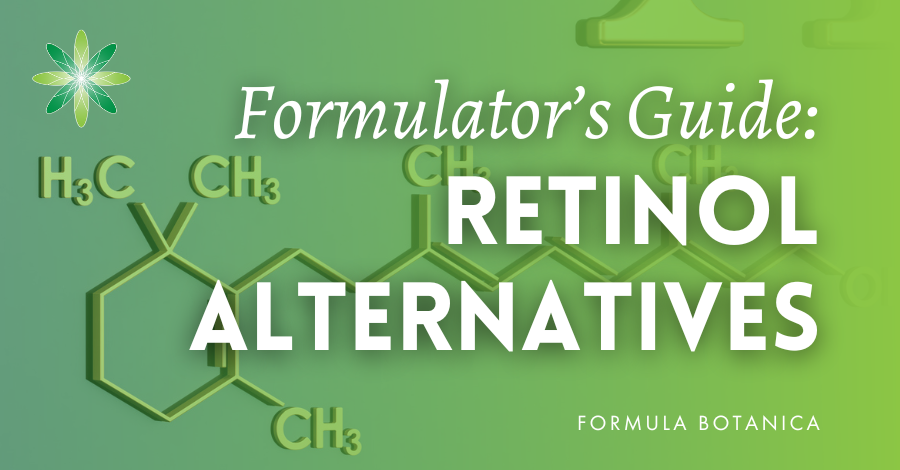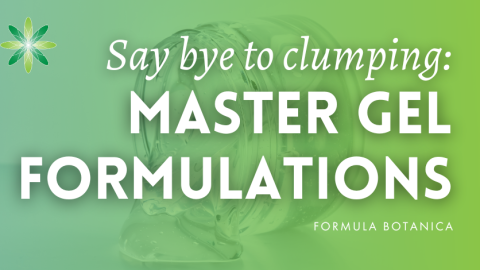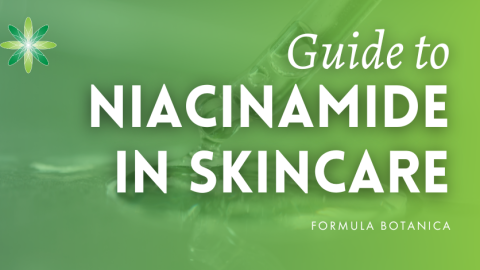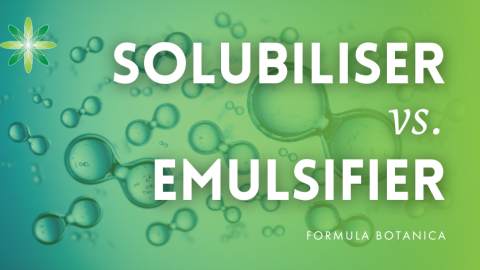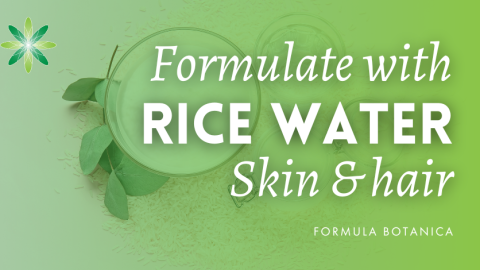Welcome to the Formulator’s Guide to superfruits in skincare. When you first start formulating organic skincare or haircare, you’ll soon become inspired by the amazing ingredients. When it comes to skincare, nothing can beat an organic cold pressed plant oil, a freshly distilled flower water, an exotic botanical butter, a high performance plant extract or an exquisitely fragrant essential oil.
Did you know that you can also formulate with fruits and vegetables? The big trend in cosmetics at the moment is working with superfruits. But what are superfruits in skincare and should we even be taking this concept seriously in our organic formulations?
Superfruits: Scientific Concept or Pseudo-Science?
It probably won’t surprise you to learn that there is no formal definition of a superfruit. Similar to superfoods, the term ‘superfruit’ is used in marketing language to promote fruits that are thought to contain higher levels of antioxidants than ‘regular’ fruits.
You will see many companies that claim that the fruits or supplements they sell contain higher levels of antioxidants than other fruits. They undertake tests to grind up their fruits and put the extracts in a test tube with free radicals. The assumption is then made that the more free radicals the superfruit disables, the more powerful the antioxidants are.
However, as you can probably understand, the results of these tests vary depending on the part of the fruit used, which harvest is included and even the lab that undertakes the test. Botanical ingredients are inherently variable, which means that we generally cannot rely on such superfruit claims.
So what is a superfruit? In our opinion, every fruit is a superfruit. Fruit is fundamentally packed with nutrients and vitamins, whether you are eating it for breakfast or using it in your daily skincare.
In fact, a 2010 analysis of the antioxidant content of more than 3100 foods, beverages, spices, herbs and supplements used worldwide found that most berries, fruits and vegetables contained some antioxidant activity (with the exception of celery, which isn’t a fruit!), as well as other interesting chemical compounds. Certain fruits are higher in antioxidants than others, but again, this very much depends on the test undertaken.
Read more: 38 Colourants for Organic Skincare
Superfruit Antioxidants for the Skin
The next question is whether those antioxidants can have an effect on the skin. There are many different types of antioxidants in our foods, including Vitamin E, Vitamin C, Vitamin A, selenium and ubiquinone.
Read more: How to make a High Performance Vitamin E Serum
The other type of molecule found in foods that can have a benefit on the skin is polyphenols. Polyphenols evolved to protect plants from their environments and are thought to therefore be great at potentially combatting free radicals.
Polyphenols are generally split into 4 separate groups: phenolic acids, flavonoids, lignans and stilbenes. Phenolic acids and flavonoids are the most common chemicals found in plants and therefore, have undergone the most research.
In other words, we encourage you to get creative with all fruits in your formulations. Being an organic skincare formulator, you learn to appreciate even the most simple of plants for their wondrous abilities. Sea buckthorn might be a powerhouse for its carotenoids, but humble sweet almond oil certainly doesn’t lack benefits either. There is a wonderful variety of superfruits in skincare that can be incorporated in to your formulations.
Read @FormulaBotanica's Formulator's Guide to Superfruits in Skincare #naturalskincare #greenbeauty #superfruits Share on X
How to add Superfruits in Skincare
Once you have decided which fruits you’re inspired to add to your formulations, it’s time to decide what form those superfruits will take in your skincare. Luckily, you have a huge array of ingredient types to choose from and we often see our students work with exciting new ingredients that they’ve sourced from all across the world.
Fruit Carrier Oils
Carrier oils offer perhaps the easiest and most obvious way of incorporating fruit in skincare. The most natural way to extract carrier oils is by cold pressing the fruit, most commonly the seeds, to realise the lipids. Carrier oils contain the oil-soluble components of the plant and cold pressing the oil ensures that it retains as much of the plant’s nutrients as possible.
There are endless ways to use carrier oils in skincare, ranging from facial oils and day creams to masques and scrubs. Carrier oils can make up anywhere from 1% to 100% of the formulation. Not all oils are heat sensitive, but some are, so it’s best to do some research on your chosen carrier oil.
Examples of fruit carrier oils: blueberry seed oil, strawberry seed oil, raspberry seed oil, apricot kernel oil, grape seed oil, plum kernel oil.
Read more: The Chemist’s Guide to Checking Plant Oils for Heat Sensitivity
Fruit Essential Oils
Most cosmetic formulators will be familiar with essential oils, particularly as they are one of the first ingredients taught in Formula Botanica’s award-winning online courses such as our Diploma in Organic Skincare Formulation.
Essential oils are used primarily as aromaceuticals to give your formulation its scent, but they also contain some of the oil-soluble components of the plant. These oils are a very concentrated form of the plant so should never be used neat on the skin. They are made either through steam distillation, expeller pressing or sometimes solvent extraction.
Essential oils can be used in any formulation with an oil phase, lotions, body butters or facial oils etc. They can also be added to water-based formulations, however this requires using a solubiliser to disburse the small amount of oil in the water. Essential oils should always be added during the cool down phase of your formulation, when the temperature is below 40 degrees Celsius.
Examples of fruit essential oils: grapefruit essential oil, lime essential oil, sweet orange essential oil, red mandarin essential oil.
Read more: Guide to 4 Natural Solubilisers for Cosmetic Formulating
Fruit CO2 Extracts
CO2 extracts are concentrated, oil-based extracts that have been extracted through the use of CO2, without exposing the plants to heat or solvents. These extracts sometimes also contain the plant’s essential oil, as well as other oil-soluble components of the plant. They offer a very effective way of harnessing the therapeutic benefits of a plant without the same sensitivity risk you might have with essential oils.
These extracts can be used in any formulation with an oil phase, or in a water-based product with the use of a solubiliser. CO2 extracts should always be added to your formulation when the temperature is under 40 degrees Celsius.
Examples of fruit CO2 extracts: arctic blackcurrant CO2 extract, sea buckthorn pulp CO2 extract, rosehip CO2 extract.
Read more: What are CO2 extracts? Mystery & Methods Explained
Fruit Glycerol Extracts
A glycerol extract is a water-soluble extract of a plant or fruit infused into vegetable glycerine. As glycerine is a humectant, not only do you get the benefits from the plant, but you also get the moisturising properties of the glycerine itself.
Glycerol extracts are generally recommended for use between 3-6% of your total product. They are safe to use in higher percentages but the end product can be sticky with a higher volume of glycerine. They are used in products with a water phase and added when the temperature s below 40C.
Examples of fruit glycerol extracts: acerola glycerol extract, raspberry glycerol extract, pomegranate glycerol extract, papaya glycerol extract.
Read more: How to make Glycerites with Fresh Food
Fruit Powders
Fruit powders are primarily made through freeze drying or spray drying, either using the fruit itself or the extract. The fruit is then ground up, from small chunks to a fine powder. Many fruit powdered are sold for consumption and contain the vitamins and nutrients found within the plant.
Fruit powders are very versatile and can be used in all types of formulations, ranging from cleansers to masques. They offer an excellent, gentle exfoliating properties in scrubs, or a colourful touch to masques and body wraps.
Examples of fruit powders: raspberry leaf powder, rosehip powder, bilberry powder, raspberry powder.
Read more: How to make a Dragonfruit Powder-to-Foam Cleanser
Fruit-derived Alpha Hydroxy Acids
Alpha-Hydroxy Acids (AHAs) are another buzzword ingredient in today’s world of skincare. AHAs are extremely popular, high powered ingredients that are best known for the way they exfoliate without the risk of creating the microscopic tears on the skin that can occur from harsher physical exfoliants such as walnut shell.
These acids are often derived from natural sources, sometimes fruit. Blends of fruit-derived AHAs are available to buy as a formulator, they are derived from fruits like lemons, oranges, blueberries and sugar cane (not a fruit).
AHAs are water soluble and can be used in leave-on or rinse-off products. Because AHAs thin the top layer of the skin through chemical exfoliation, they can however leave the skin more vulnerable to UV radiation. For that reason, over-the-counter cosmetic products are limited to a maximum of 10% AHAs. However, we recommend that any formulators who are starting out with this type of chemical compound start much lower in terms of concentration. Keep in mind these ingredients will also lower your product’s overall pH.
6 Fantastic Superfruits in Skincare
As you’ve now probably gathered, the possibilities of using different superfruit ingredients in skincare are endless. There are so many fruits with such a variety of amazing properties, whether you eat them or apply them topically. If I wrote about them all here, this blog post would be a full length encyclopaedia!
So I have broken it down to 6 of my favourite superfruits in skincare, some of the trendiest and the ones most suited for use in your formulations.
Acai Berry
• INCI: Euterpe Oleracea
• Key benefits: Antioxidant, anti-ageing, emollient, essential fatty acids, Vitamins A,B,C
• Available as: Carrier oil, Extract, Powder
• Best for: Anti-Ageing
Acai berry is a little purple berry that packs a huge antioxidant punch. It found its fame as a superfruit with the rise of the beloved acai bowl and it does just as much for your skin externally as it does internally. Acai berry yields a stable oil rich in anthocyanins and flavonoids and contains with thiamine, riboflavin and niacin (water-soluble). Acai protects the skin from external pollutants, supports the production of collagen and is highly moisturising.
Acerola Cherry
• INCI: Malpighia emarginata
• Key benefits: Antioxidant, Vitamin C, Moisturising, Vitamin A
• Available as: Extract, Powder
• Best for: Restoring
Acerola cherries, although they are not actually cherries, earn their super fruit status for their stellar Vitamin C content. In fact, just one acerola cherry has the same amount of natural Vitamin C as 65 Oranges! This vitamin C (also an antioxidant) is vital for the skin to produce collagen. This bright berry is also high in vitamin A, thiamin, riboflavin, and niacin which are needed to revitalise skin.
Avocado
• INCI: Persea gratissima
• Key benefits: Vitamin E, Chlorophyll, Nourishing
• Available as: Carrier Oil, Powder
• Best for: Nourishing
This fruit is another Instagram favourite (are you following us on Instagram yet?). As well as being delicious, avocados are brilliant for your skin because they contain hight amounts of vitamin E and chlorophyll.
Chlorophyll is the pigment that makes plants green and is naturally oil-soluble. The chlorophyll and carotenoids found in avocados are in avocado oil as well. When applied to the skin topically, chlorophyll is beneficial to the skin and has even been used in acne trials (although this involved using the water-soluble chlorophyllin in a gel).
Blackcurrant
• INCI: Ribes Nigrum
• Key benefits: Gamma Linolenic Acid, Polyphenols, Essential Fatty Acidss
• Available as: Extract, Powder, Carrier Oil
• Best for: Anti-Ageing
These little purple berries are probably best known as the main ingredient in Ribena, the juice drink that’s been popular in Europe for many decades. The drink was originally made as a supplement for children to prevent scurvy during the war, as it contains a lot of Vitamin C. Blackcurrants, along with rosehips, were foraged and consumed for their Vitamin C, as citrus fruits were banned from being imported to the UK.
When it comes to skincare, these berries are high in Gamma Linolenic Acids, which aren’t naturally produced by our bodies, so they need to be consumed through our food. They also contain polyphenols, our superfruit antioxidants.
Kalahari Melon
• INCI: Citrullus Vulgaris
• Key benefits: linolenic acid, antioxidants. EFA’s
• Available as: Carrier oil, Powder
• Best for: Balancing
This melon is a lesser known superfruit with the nickname the wild watermelon. Kalahari melon is grown mostly in Botswana and Namibia, and the seeds are harvested and sun dried before being pressed into an oil. Kalahari Melon seed oil works well for oil- or cream-based cleansing formulations, as it contains between 50% and 70% linolenic acid. When used as a cleanser, it works to remove excess sebum from the surface of your skin. It is easily absorbed and very nourishing as a moisturiser because it contains Omegas 6 and 9.
Papaya
• INCI: Carica Papaya
• Key benefits: Papain, Vitamin C, Antioxidants
• Available as: Extract, Powder
• Best for: Brightening
Papayas, like many tropical fruits, are high in vitamins A and C. Papaya’s key differentiator is an enzyme called papain, which works to exfoliate and brighten the skin by increasing cellular regeneration. This enzymatic effect works in a similar way to Alpha Hydroxy Acids. This process in turn can help to reduce hyperpigmentation such as acne scars and sun spots.
We hope you enjoyed our run-down of superfruits in skincare and that this article has given you some inspiration for your own formulations. Which is your favourite superfruit? How do you like to work with superfruits in skincare? Share your tips for our readers in the comments below.
Want to enrol to learn how to become an organic skincare formulator and use these wonderful superfruits in your own formulations? Sign up for our free mini course now.
FREE TRAINING
Learn how to become an
Organic Skincare Formulator
FREE TRAINING
How to become an
Organic Skincare Entrepreneur
FREE TRAINING
How to become an
Organic Skincare Entrepreneur
Leave us a comment

Brooke Medhurst is a Tutor at Formula Botanica. Find out more about the Formula Botanica Team.










